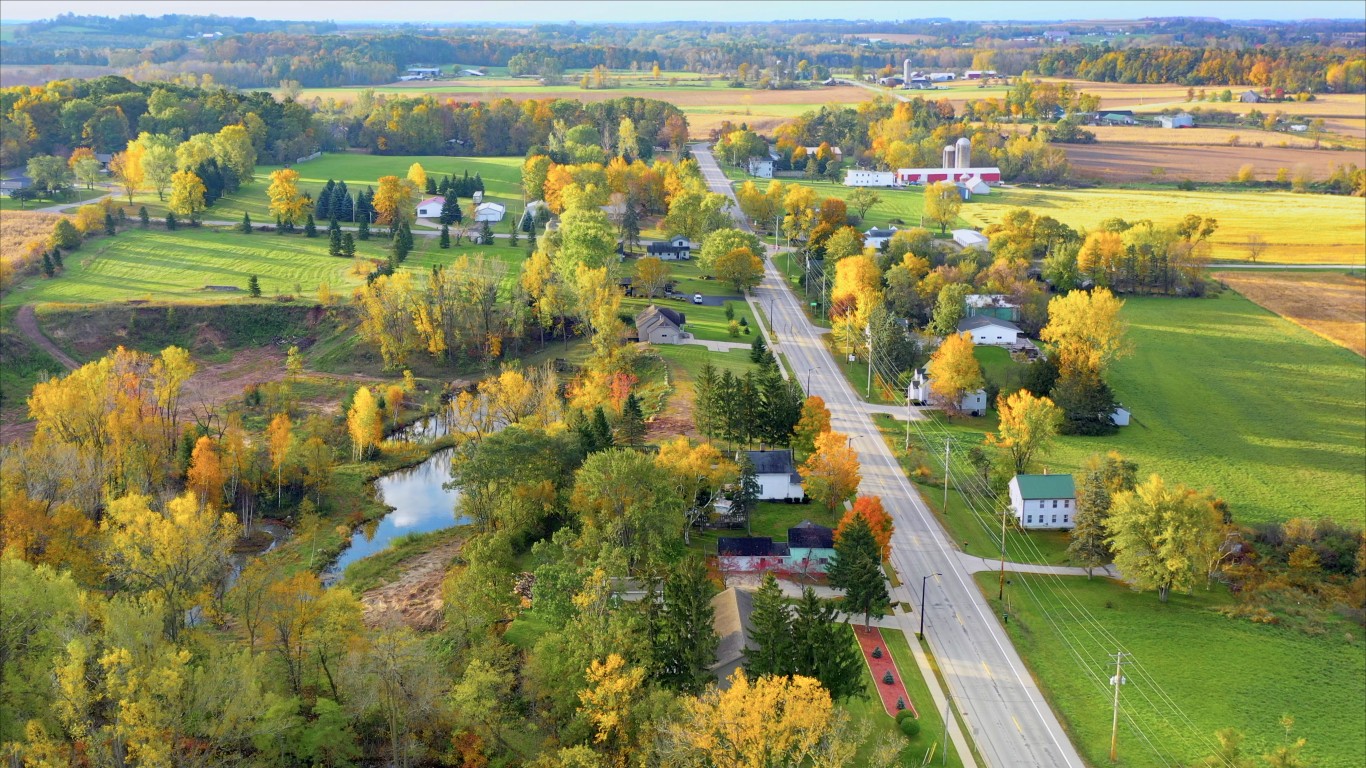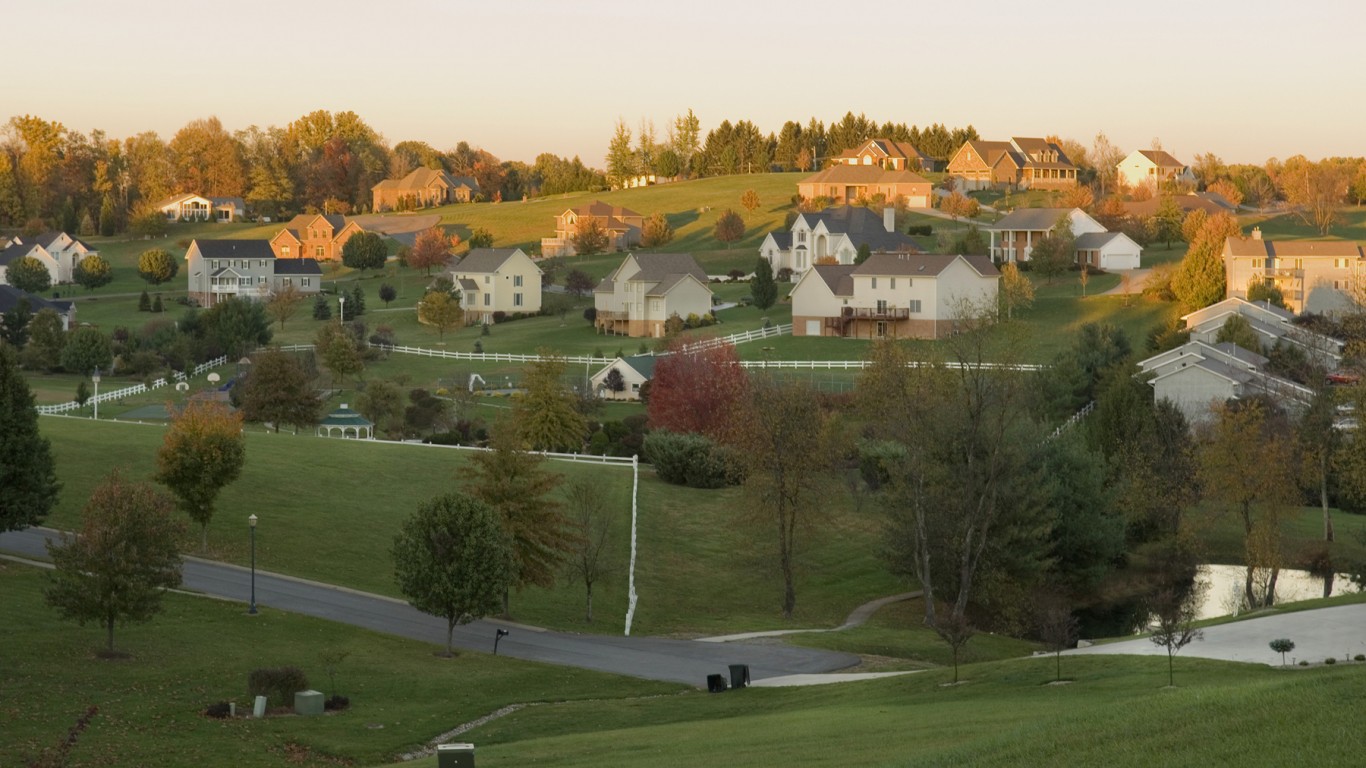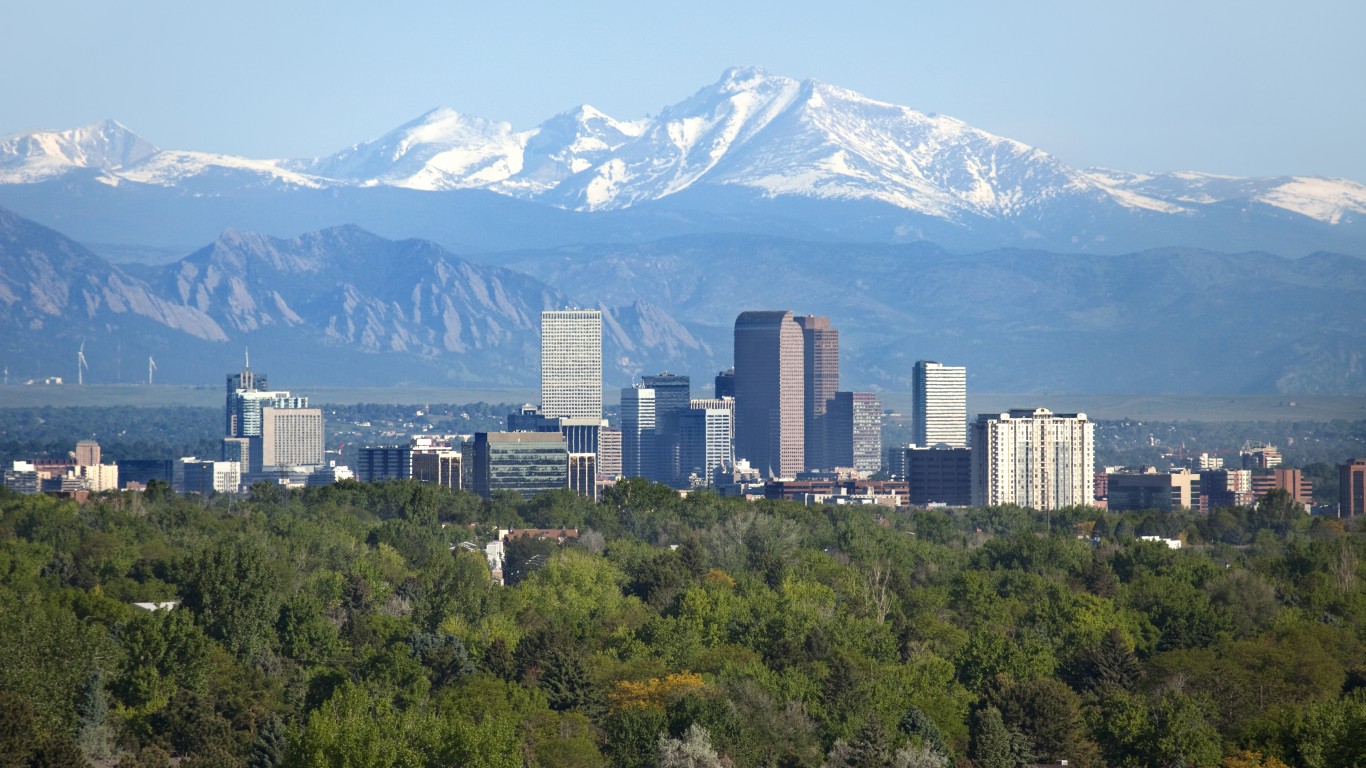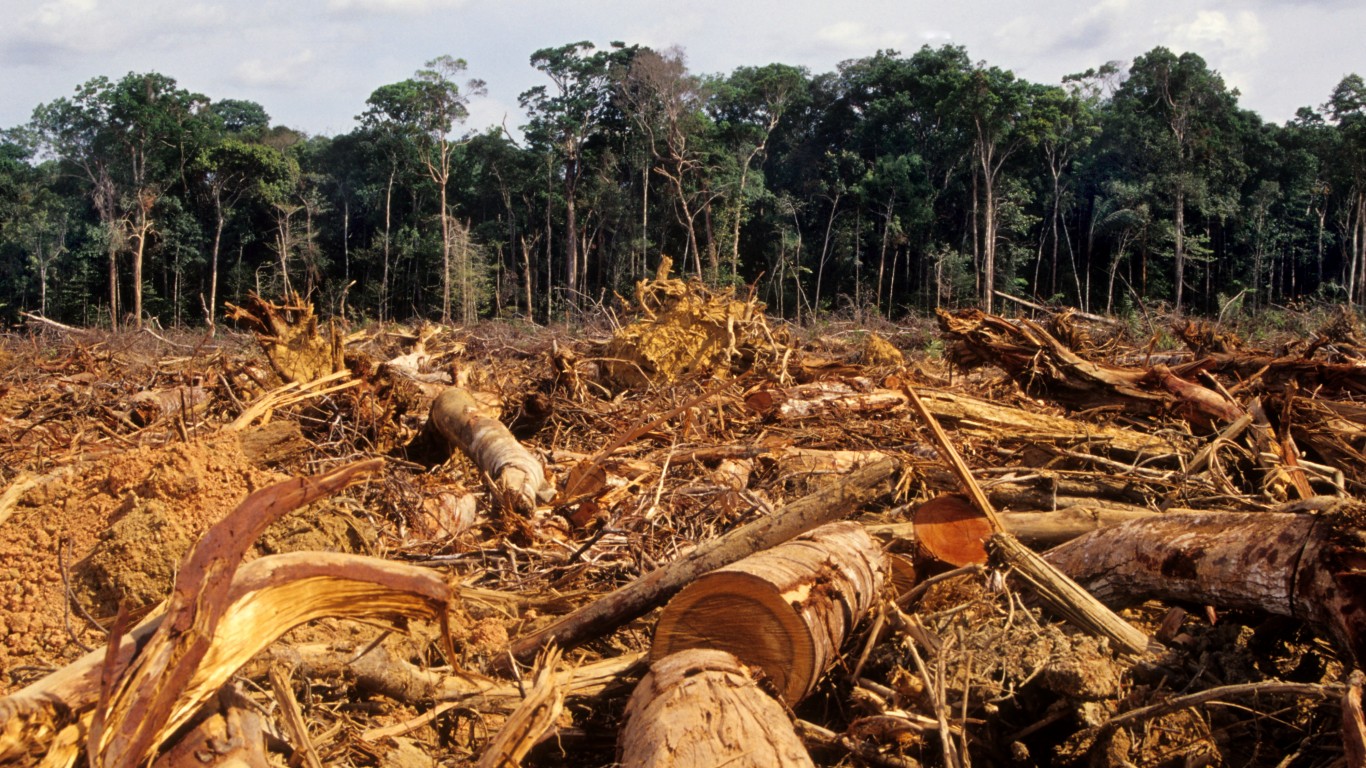
As interest in beekeeping has grown in the US over the last few decades, honey bee colonies have continued to experience high mortality rates. In the winter of 2020-21, American beekeepers saw the second worst honey bee colony loss of the last 15 years, with a state average of 32.2% winter hive mortality and a high of 58.5% mortality.
These numbers represent a 9.6% increase from the previous winter, and at least a 12% from historical estimates in the U.S. that placed winter hive mortality at under 20%. Here are the biggest threats to U.S. bee populations.
Honey bee populations, both wild and managed, are crucially important to human foodsystems. According to the FDA, over 90 commercially produced crops require bee pollination; and bee pollination accounts for $15 billion in added crop value. Here are crops that would be most affected if honey bees disappeared.
To identify how honey bee colonies are doing in every state, 24/7 Wall St. looked at honey bee winter losses in bee colonies from beeinformed.com. Loss estimates for each state were adjusted in August 2020. The number of beekeepers and colonies in each state also come from Bee Informed. State population figures came from the U.S. Census Bureau’s 2020 American Community Survey and are 5-year estimates. The following states did not have enough data available for bee colonies or winter loss: Alaska, Arizona, Hawaii, Louisiana, Mississippi, Nebraska, Nevada, South Dakota.
Winter is generally the most dangerous time for bees, as they don’t hibernate and need to maintain a stable hive temperature. This is achieved by a number of worker bees eating stored food to fuel the formation of a thermoregulation cluster that generates heat for the hive. Thus, food stockpiles and winter temperatures can greatly impact hive survival.
A number of additional factors also impact hive mortality, including summer weather conditions that affect the bees’ ability to forage and store food, as well as pesticide exposure, the forage quality surrounding the hive, and parasite and pathogen infestations. Varroa mites, which can transmit viruses to bees as they feed on their blood, are the single biggest threat to honey bee health and the main cause of colony collapse disorder.
Apiary management of mites and pathogens can greatly affect winter survival rates, as can temperature regulation achieved by wrapping hives with insulative materials. Of the states with the highest hive mortality rates, many are in colder northern areas of the U.S., including Michigan, Connecticut, New Hampshire, and Vermont.
Click here to see states that lost the most bee colonies last winter

42. New Mexico
> Total winter loss, 2020/2021: 21.7%
> Beekeepers: 11 – 3rd lowest
> Colonies: 100 – the lowest
> State population: 2,097,021 – 11th lowest
[in-text-ad]

41. Wisconsin
> Total winter loss, 2020/2021: 22.6%
> Beekeepers: 76 – 15th highest
> Colonies: 3,955 – 14th highest
> State population: 5,806,975 – 19th highest

40. Oklahoma
> Total winter loss, 2020/2021: 22.7% (tie)
> Beekeepers: 29 – 12th lowest
> Colonies: 4,314 – 13th highest
> State population: 3,949,342 – 17th lowest

39. Idaho
> Total winter loss, 2020/2021: 22.7%
> Beekeepers: 23 – 9th lowest
> Colonies: 11,129 – 8th highest
> State population: 1,754,367 – 9th lowest
[in-text-ad-2]

38. Alabama
> Total winter loss, 2020/2021: 27.5%
> Beekeepers: 57 – 17th lowest
> Colonies: 1,218 – 20th lowest
> State population: 4,893,186 – 20th lowest
37. Indiana
> Total winter loss, 2020/2021: 28.2%
> Beekeepers: 65 – 21st highest
> Colonies: 1,491 – 20th highest
> State population: 6,696,893 – 16th highest
[in-text-ad]

36. Oregon
> Total winter loss, 2020/2021: 29.2%
> Beekeepers: 79 – 14th highest
> Colonies: 20,344 – 5th highest
> State population: 4,176,346 – 18th lowest

35. Virginia
> Total winter loss, 2020/2021: 29.6% (tie)
> Beekeepers: 193 – 2nd highest
> Colonies: 2,615 – 16th highest
> State population: 8,509,358 – 12th highest

34. Rhode Island
> Total winter loss, 2020/2021: 29.6% (tie)
> Beekeepers: 12 – 4th lowest
> Colonies: 170 – 3rd lowest
> State population: 1,057,798 – 5th lowest
[in-text-ad-2]

33. New Jersey
> Total winter loss, 2020/2021: 29.9%
> Beekeepers: 62 – 19th lowest
> Colonies: 685 – 13th lowest
> State population: 8,885,418 – 11th highest

32. Minnesota
> Total winter loss, 2020/2021: 30.7%
> Beekeepers: 74 – 16th highest
> Colonies: 11,311 – 7th highest
> State population: 5,600,166 – 21st highest
[in-text-ad]

31. North Carolina
> Total winter loss, 2020/2021: 30.8%
> Beekeepers: 104 – 12th highest
> Colonies: 1,483 – 21st highest
> State population: 10,386,227 – 9th highest

30. California
> Total winter loss, 2020/2021: 31.0%
> Beekeepers: 110 – 10th highest
> Colonies: 169,011 – the highest
> State population: 39,346,023 – the highest

29. Kentucky
> Total winter loss, 2020/2021: 31.4%
> Beekeepers: 69 – 17th highest
> Colonies: 1,039 – 19th lowest
> State population: 4,461,952 – 19th lowest
[in-text-ad-2]

28. Washington
> Total winter loss, 2020/2021: 31.8%
> Beekeepers: 81 – 13th highest
> Colonies: 33,288 – 3rd highest
> State population: 7,512,465 – 13th highest

27. North Dakota
> Total winter loss, 2020/2021: 32.1%
> Beekeepers: 10 – 2nd lowest
> Colonies: 42,480 – 2nd highest
> State population: 760,394 – 3rd lowest
[in-text-ad]

26. South Carolina
> Total winter loss, 2020/2021: 32.3%
> Beekeepers: 26 – 11th lowest
> Colonies: 538 – 12th lowest
> State population: 5,091,517 – 21st lowest

25. Missouri
> Total winter loss, 2020/2021: 34.3%
> Beekeepers: 66 – 18th highest
> Colonies: 817 – 16th lowest
> State population: 6,124,160 – 17th highest

24. Maine
> Total winter loss, 2020/2021: 36.4%
> Beekeepers: 59 – 18th lowest
> Colonies: 514 – 11th lowest
> State population: 1,340,825 – 7th lowest
[in-text-ad-2]

23. West Virginia
> Total winter loss, 2020/2021: 36.9%
> Beekeepers: 37 – 14th lowest
> Colonies: 1,324 – 21st lowest
> State population: 1,807,426 – 10th lowest

22. Texas
> Total winter loss, 2020/2021: 37.6%
> Beekeepers: 158 – 5th highest
> Colonies: 31,405 – 4th highest
> State population: 28,635,442 – 2nd highest
[in-text-ad]

21. Florida
> Total winter loss, 2020/2021: 38.0%
> Beekeepers: 166 – 3rd highest
> Colonies: 9,368 – 9th highest
> State population: 21,216,924 – 3rd highest

20. Georgia
> Total winter loss, 2020/2021: 38.3%
> Beekeepers: 121 – 9th highest
> Colonies: 3,020 – 15th highest
> State population: 10,516,579 – 8th highest

19. Maryland
> Total winter loss, 2020/2021: 38.8%
> Beekeepers: 154 – 6th highest
> Colonies: 2,039 – 19th highest
> State population: 6,037,624 – 18th highest
[in-text-ad-2]

18. New York
> Total winter loss, 2020/2021: 39.3%
> Beekeepers: 124 – 8th highest
> Colonies: 2,550 – 17th highest
> State population: 19,514,849 – 4th highest

17. Montana
> Total winter loss, 2020/2021: 40.4%
> Beekeepers: 19 – 7th lowest
> Colonies: 11,723 – 6th highest
> State population: 1,061,705 – 6th lowest
[in-text-ad]

16. Tennessee
> Total winter loss, 2020/2021: 40.6%
> Beekeepers: 66 – 18th highest
> Colonies: 490 – 9th lowest
> State population: 6,772,268 – 15th highest

15. Ohio
> Total winter loss, 2020/2021: 40.7%
> Beekeepers: 108 – 11th highest
> Colonies: 990 – 18th lowest
> State population: 11,675,275 – 7th highest

14. Pennsylvania
> Total winter loss, 2020/2021: 41.3%
> Beekeepers: 570 – the highest
> Colonies: 5,449 – 11th highest
> State population: 12,794,885 – 5th highest
[in-text-ad-2]

13. Kansas
> Total winter loss, 2020/2021: 41.6% (tie)
> Beekeepers: 13 – 6th lowest
> Colonies: 306 – 6th lowest
> State population: 2,912,619 – 12th lowest

12. Colorado
> Total winter loss, 2020/2021: 41.6% (tie)
> Beekeepers: 66 – 18th highest
> Colonies: 714 – 14th lowest
> State population: 5,684,926 – 20th highest
[in-text-ad]

11. Arkansas
> Total winter loss, 2020/2021: 43.8%
> Beekeepers: 21 – 8th lowest
> Colonies: 335 – 7th lowest
> State population: 3,011,873 – 13th lowest

10. Massachusetts
> Total winter loss, 2020/2021: 44.9%
> Beekeepers: 126 – 7th highest
> Colonies: 2,121 – 18th highest
> State population: 6,873,003 – 14th highest

9. Delaware
> Total winter loss, 2020/2021: 46.3%
> Beekeepers: 13 – 6th lowest
> Colonies: 958 – 17th lowest
> State population: 967,679 – 4th lowest
[in-text-ad-2]

8. Wyoming
> Total winter loss, 2020/2021: 46.6%
> Beekeepers: 10 – 2nd lowest
> Colonies: 154 – 2nd lowest
> State population: 581,348 – the lowest

7. Illinois
> Total winter loss, 2020/2021: 47.1%
> Beekeepers: 64 – 21st lowest
> Colonies: 803 – 15th lowest
> State population: 12,716,164 – 6th highest
[in-text-ad]

6. Vermont
> Total winter loss, 2020/2021: 47.9% (tie)
> Beekeepers: 24 – 10th lowest
> Colonies: 263 – 5th lowest
> State population: 624,340 – 2nd lowest

5. New Hampshire
> Total winter loss, 2020/2021: 47.9% (tie)
> Beekeepers: 35 – 13th lowest
> Colonies: 204 – 4th lowest
> State population: 1,355,244 – 8th lowest

4. Connecticut
> Total winter loss, 2020/2021: 49.8%
> Beekeepers: 51 – 16th lowest
> Colonies: 448 – 8th lowest
> State population: 3,570,549 – 16th lowest
[in-text-ad-2]

3. Michigan
> Total winter loss, 2020/2021: 51.2%
> Beekeepers: 160 – 4th highest
> Colonies: 8,978 – 10th highest
> State population: 9,973,907 – 10th highest

2. Utah
> Total winter loss, 2020/2021: 51.8%
> Beekeepers: 63 – 20th lowest
> Colonies: 4,821 – 12th highest
> State population: 3,151,239 – 15th lowest
[in-text-ad]
1. Iowa
> Total winter loss, 2020/2021: 58.5%
> Beekeepers: 44 – 15th lowest
> Colonies: 512 – 10th lowest
> State population: 3,150,011 – 14th lowest
Get Ready To Retire (Sponsored)
Start by taking a quick retirement quiz from SmartAsset that will match you with up to 3 financial advisors that serve your area and beyond in 5 minutes, or less.
Each advisor has been vetted by SmartAsset and is held to a fiduciary standard to act in your best interests.
Here’s how it works:
1. Answer SmartAsset advisor match quiz
2. Review your pre-screened matches at your leisure. Check out the advisors’ profiles.
3. Speak with advisors at no cost to you. Have an introductory call on the phone or introduction in person and choose whom to work with in the future
Get started right here.
Thank you for reading! Have some feedback for us?
Contact the 24/7 Wall St. editorial team.

 24/7 Wall St.
24/7 Wall St. 24/7 Wall St.
24/7 Wall St.